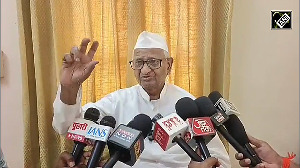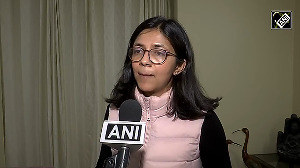The stock markets have looked up, corporate results have been better than expected, yet domestic companies are less than bullish about prospects of an early recovery. Most of them are worried about whether demand will be sustained this fiscal because the investment pipeline has narrowed and no greenfield projects are being planned.
Private corporate spending, which had touched 16 per cent of GDP in recent years, had played a key role in India posting 9 per cent growth in the last three years till March 2008. If there's a sharp decline in this, companies fear it will hurt demand.
Indeed, some like JSW Steel joint MD Seshagiri Rao fear that things may worsen from here unless people are able to raise money and start investing again. Banks say both current accounts and credit off-take remains subdued.
Consider the investment pipeline. According to new project tracker ProjectsToday.com the value of new projects announced by Indian companies shrank 51 per cent in the second half of 2008-09 to Rs 283,722 crore (Rs 2,837.22 billion) from Rs 578,912 crore (Rs 5,789.12 billion) in the first half, with the number of projects falling to 5,421 from 7,112 in the first half.
The manufacturing sector saw a sharper decline. The value of new projects announced in the second half of 2008-09 fell 63.83 per cent to Rs 66,849 crore (Rs 668.49 billion) from Rs 184,810 crore (Rs 1,848.1 billion) in the first half.
''The investment scenario is a huge, huge risk hanging over our system,'' said Abheek Barua, chief economist, HDFC Bank. In a pick-up year, private investment grows at over 20 per cent, he said, but right now ''there's no improvement in investment-related credit, there's so much uncertainty".
India's 9 per cent growth was led by investment demand, which touched a high of 40 per cent of GDP, after averaging 25 per cent for many years. Economic reforms in the early 1990s and after 2002 encouraged private corporate investment, which touched 16 per cent of GDP in recent years and surpassed government spending for the first time.
Ajay Shah, senior fellow at the National Institute of Public Finance and Policy, said household consumption and government spending doesn't fluctuate much; it is private corporate investment that responds to fluctuations in business cycles.
''If the recent upsurge of private corporate investment reverses itself, we could see a drop from 16 per cent of GDP to 6 per cent of GDP,'' Shah said.
''Each percentage point of GDP today is Rs 50,000 crore (Rs 500 billion); so we are discussing massive numbers. A 10 percentage point decline in private corporate investment is a decline in investment demand of Rs 500,000 crore (Rs 5,000 billion),'' he added.
Andrew Holland, head of institutional equities, Ambit Capital, says companies will not resume investing when they are laying off people and foreign direct investment in manufacturing has slowed (for instance, Mittal Steel has deferred its steel project in India). ''When companies are looking at cost structures they are unlikely to think of expansions or new projects,'' he said.
Consider the other demand drivers. Economists say household consumption is stable; in fact, the Pay Commission and the rural economy are counter-cyclical factors at work. They say if government spending can be sustained, it can partially offset the fall in private corporate investments.
''Consumer and government spending will partially offset the slowdown in exports and private investment but they will not entirely do so,'' said Subir Gokarn, chief economist, Standard & Poor's Asia Pacific.
Government spending is unlikely to fill the gap because it amounts to only a tenth of India's output. Moreover, one rupee spent by private firms is more effective than by the government because of leakages.
Some sectors, however, could continue to do well, like cement, which is being fuelled by rural demand. But ACC MD AL Kapur said there could be a supply overhang because 40 to 45 million tonne of fresh capacity will be added this fiscal, though only half of this will come to market since it takes time to ramp up capacity.
Similarly, though large engineering companies like ABB and Larsen & Toubro continue to be bullish, analysts say the pace of new orders has slowed. Some power projects have achieved financial closure but most of them are still struggling to tie up funds.
On the positive indicators economists say there is no need to get carried away. ''Whatever improvements in the non-consumer sectors, it is because of inventory adjustments,'' said Barua. He suspects this could be a W-shaped recovery like in 1999, when there's a recovery for a few months but demand slumps again.
''When demand falls off a cliff, you cut inventories to match sales. Globally, inventories are still at high levels and sales have fallen faster than inventories,'' said Holland. Figures from the US and China show signs of recovery, but there's still contraction, he added.
''Things are stabilising but it doesn't mean we start investing in new projects, which is still six to nine months away,'' he said.
Even if the new government decides to boost spending on infrastructure, it will take three to six months to feed the demand (a new road, for instance, would take three months to dig up before it starts consuming steel or cement).
With equity markets still in limbo, new capacities would have been largely funded by debt. ''Steel-makers would have invested Rs 50,000 crore in adding 50 million tonne. Imagine what would have happened if these capacities had come up in a downturn. These debts could have been a burden on the banking system,'' said Arvind Parakh, Chief Financial Officer, JSL Ltd (formerly Jindla Strips).







 © 2025
© 2025